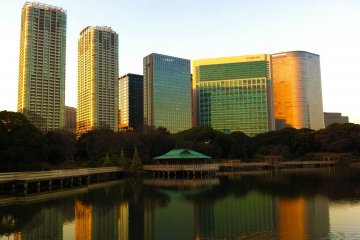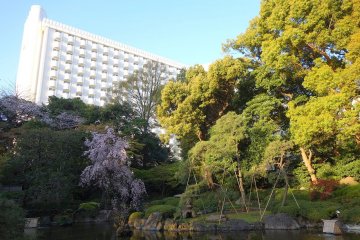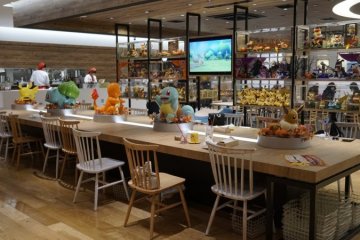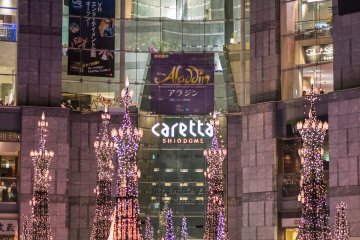
Hamarikyu Garden
Francesco AgrestiExplore one of Tokyo’s most attractive and historic landscape gardens in the heart of Shiodome.

Hamarikyu Gardens is a traditional landscape garden located on the edge of Tokyo’s Sumida River. During the Edo Period (1603-1868), the grounds were used by successive members of the Tokugawa Shogunate. A small residence was built and the shoguns and their retainers would use the duck hunting ponds on the grounds for sport. The garden changed hands during the Meiji Restoration and became the property of the Imperial Family, with the new name of Hama Detached Palace.
After suffering damage during both the Great Kanto Earthquake of 1923 and the air raids of 1945, the garden was given over to the city and opened to the public in 1946. Today, Hamarikyu is one of the nine gardens in the Tokyo Metropolitan Garden system.
The garden encompasses 62 acres on the edge of the Tsukiji and Shiodome neighborhoods. The garden’s large pond is the only remaining seawater pond in Tokyo, and sluice gates in the garden regulate the water level based on the tide.
A beautiful spot for a restful break in the garden is the Nakajima Tea House, which sits on an island in the garden’s main pond. The teahouse serves a cup of green tea and a selection of traditional sweet to visitors who prefer to enjoy the views with a bit of a refreshment.
In recent years, the city has also made great strides in reconstructing several of the historic tea houses that formerly stood in the garden. Both the Matsu no ochaya (Pine Tea House) and the Tsubame no ochaya (Swallow Tea House) have been rebuilt and stand ready to welcome visitors.
While the park is beautiful in any season, it is particularly known for its February display of plum blossoms and nanohana (rapeseed). One of the most impressive plants in the garden, however, is the 300-year-old black pine right inside the main gate, whose beauty remains constant no matter the season.
Oedo Subway line to Shiodome Station

Explore one of Tokyo’s most attractive and historic landscape gardens in the heart of Shiodome.

Hama-rikyu is a beautiful garden located in the Shiodome area of central Tokyo. This is a family garden of Tokugawa Shogun. In the Edo period the garden's ponds were connected to the Tokyo Bay. It features a 300 year old pine tree and a field of wild flowers, making it a nice garden to take a stroll. There is also a tea house where is possible to do a tea ceremony.

Once a vacation home of a Daimyo, a Shogun and the Emperor, the water level of a pond inside this beautiful garden ebbs and flows along with the tides of Tokyo Bay.

Hamarikyu Gardens: Yes, it's possible to relax even in the big city of Tokyo. Proof that Tokyo has a great balance of Nature and Urbanization!

In the middle of March, at the onset of the spring, the flowers at Hamarikyu Garden in Tokyo start to bloom, with the rapeseed yellow flowers being first in the line.

Ume Blossoms at Hamarikyu Garden in Tokyo bloom in February, showing that Spring is just around the corner!

Oakwood Premier Tokyo comes from a brand of standout luxury hotel & service apartments right at the heart of the Tokyo metropolis. It is located in the business hub of Marunouchi with JR Tokyo Station in close proximity. This will allow guests and travelers to easily access the city's extensive transport network and visit various landmarks such as Imperial Palace, Tsukiji Fish Market, Ginza and Shopping District. Boasting 123 luxurious apartments on the upper floors of a multi-serviced complex, each room offers a magnificent view of the city, not to mention all furnished and a fully-equipped kitchen set which is rarely seen in your everyday service apartment. Without doubt, these spacious tranquil retreats are curated to give you the amenities and services of a luxury hotel and a feeling of home. They are good options for both business executives and leisure travelers from one night of a short-stay to a few weeks/months of mid-to-long-term stay.

ANA Holiday Inn Tokyo Bay (previously Dai-ichi Hotel Tokyo Seafort) is a 132-room hotel that will provide visitors to Japan’s capital city with an attractive, fresh option in the midscale space. ANA Holiday Inn Tokyo Bay will join a strong portfolio of 10 ANA Holiday Inn open and pipeline hotels across Japan, and become part of the brand’s global footprint of 1,234 open hotels and 278 pipeline properties.

Just minutes from Shinagawa Station, the Grand Prince Hotel New Takanawa is surrounded by lush greenery in the Takanawa area, with rooms offering balcony views of the nearby gardens and the surrounding Tokyo cityscape. This urban resort features convention facilities like the Hiten banquet hall, the international Convention Center Pamir, as well as a wide variety of Japanese, Chinese and Western restaurants.

The Pokémon Café in Nihonbashi, which opened in March 2018, is the latest character café in the popular series of games and series in Tokyo. The café and the adjacent Pokémon Center DX store were opened in 1997 on the occasion of the 20th anniversary of the first store. The bright café, which is furnished in warm wood tones, offers main courses, desserts and drinks - all of which are arranged with a focus on one or more Pokémon and some are suitable and limited to certain topics or seasons. You can also find exclusive merchandise here - from plush toys in chef jackets to bowls and cutlery with Pokémon motifs. They also sell Pikachu Sweets, special sweets and products with the most popular of all Pokémon as a motif. A visit to the Pokémon Café is only possible with a prior reservation, time slots can be selected from one month in advance and also in English via the website. It is located on the 5th floor of the Nihombashi Takashimaya Shopping Center, which is not far from the Tokyo and Nihonbashi stations.

Toyosu Market is a wholesale market in Tokyo located in the Koto District. It was built on man-made land in Tokyo Bay and replaces the historic Tsukiji Fish Market, which was previously the capital's famous fish market. Opened October 2018 and is the largest seafood market in the world. The market in turn consists of two separate fish markets, one for auctions and the other for general sale, plus a fruit and vegetable market. There are also restaurants and a variety of options for visitors. Tourists can watch the market from a viewing platform on the second floor and take part in guided auctions and events. However, it is no longer possible, as was previously the case in Tsukiji, for visitors to be directly at the famous tuna events, a platform was built for this, from which one can see into the interior of the market. The modern building complex also offers a roof terrace and a shrine and is easily accessible by bus and train.

If you're a fan of Quentin Tarantino’s Kill Bill, there's one Tokyo restaurant that absolutely deserves a spot on your bucket list. While you may not know it by its real name, chances are you've seen it on screen—it’s the unforgettable setting for the iconic, over-the-top showdown between The Bride and the Crazy 88. Known affectionately by fans as “The Kill Bill Restaurant,” this venue offers more than just cinematic nostalgia—it's a vibrant and unique dining experience in its own right. Located in Tokyo’s upscale Nishi-Azabu district, this classic-style izakaya bar is where fiction meets flavor. Though the fake blood and samurai swords have long been cleaned away, the spirit of the film lives on in the architecture and atmosphere. Stepping inside feels like walking onto the set: a grand, high-ceilinged hall with a central open-plan dining space, surrounded by a mezzanine-level balcony—instantly recognizable to anyone who’s watched the movie. But don’t mistake it for just a movie-themed attraction. The Kill Bill restaurant is a serious culinary destination. It offers a wide variety of traditional Japanese dishes, from sashimi and grilled skewers to noodle dishes and seasonal specialties. The menu also boasts creative fusion items like avocado and camembert tempura, which nods to the restaurant’s global popularity and mindset. And for international travelers with specific dietary needs, the restaurant provides vegan and halal-friendly menus (with at least three days’ notice). What makes this spot truly special is its ability to deliver a top-tier gourmet experience while doubling as a pop culture pilgrimage. You can sip sake where Uma Thurman once sliced through waves of enemies—minus the chaos, of course. Whether you’re a die-hard Tarantino fan, a foodie on the hunt for authentic Japanese flavors, or simply someone looking for a unique night out in Tokyo, this restaurant checks every box. Just one tip: Enjoy the drinks and dishes, but leave the swordplay to the professionals. Note: As you’d expect, Gonpachi is a popular restaurant. Same-day reservations are possible, but ideally you’ll want to reserve your table at least two days ahead of your visit, and even earlier if you’re planning to visit at the weekend.

Caretta Shiodome is a shopping and dining center in the Shiodome area of Minato-ku. It is not only home to cultural institutions such as the Tokyo Advertising Museum, but also offers unique shops and many restaurants with a variety of great dining experiences. There is also a theater a capacity of 1200 seats, where musicals are sometimes performed in Japanese. The restaurants are located 200 meters above the ground. Many restaurants on the 46th and 47th floors offer delicious dishes and fantastic views of Tokyo Tower, Tokyo Skytree, Rainbow Bridge and Ginza. Caretta Shiodome offers a wide range of events all year round, but one of the most exciting events is the impressive winter illumination. [Photo: Mahathir Mohd Yasin / Shutterstock.com]

Encounter all types of fresh foods and traditional Japanese foods in Tsukiji’s Outer Market. The market combines wholesale and retail shops into charm that lines the streets of the area and offers a unique perspective on Japan and even some original Japanese dishes. The Tsukiji Market was once a wholesale market for professionals and a place that tourists frequently visited. Particularly famous was the morning fish market where freshly caught fish would be cut and sold in large open areas of the market. Nowadays, the wholesale fish market has since moved to Toyosu (about 2 km away) back in 2018. However, this doesn’t mean that the Outer Tsukiji Market isn’t worth visiting. Colorful slices of fresh-sliced sashimi, dried seaweed, fruits, vegetables, single-servings of food, and kitchen utensils; you can find all this and more at the Outer Market in Tsukiji. In fact, many of the shops in the Outer Market simply bring their wares from Toyosu. In the Outer Market, there are buildings that are more than 80 years old. Many owners still use the first floor for their shops and live on the upper floors above street level creating an intricate maze of homes and shops. But even with this layout, Tsukiji Outer Market is a fascinating place to visit and shop. Especially for sushi and sashimi aficionados. The birth of the fish market as its known today began in 1657 when Edo was devastated by a great fire. Land was reclaimed from Tokyo Bay and named Tsukiji (築地), which means "constructed land". What was once a quiet living quarters for samurai families and shrines—one of which still sits at the back corner of the Tsukiji Market, "Namiyoke" offering protection from waves—became a hustling center of prosperous markets after the 1923 Great Kanto Earthquake. Even though half of the fish market has moved to Toyosu, the Outer Market remains a fascinating experience where tourists can rub elbows with locals and get a sense of where the fresh seafood of Tokyo comes from. The market typically opens for business at 9 am and goes on until 3 pm. This early closing time means that you want to get there early for the freshest foods before they sell out or are closed for the day. Tokyo's wholesale fish market moved to Toyosu in October 2018. Note that many shops are closed on Sundays and some Wednesdays.

Grand Hammer is a dynamic eight-story entertainment complex in Tokyo’s Shinbashi district, blending traditional Japanese culture with modern leisure. Opened in late 2024, it offers a diverse array of dining, performances, and relaxation options, making it a unique destination for both locals and tourists.